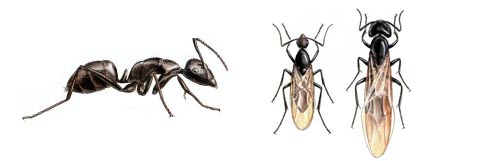Carpenter Ants
Carpenter Ants
Carpenter Ants are a problem to humans because of their habit of nesting in houses. They do not eat wood, but they remove quantities of it to expand their nesting facilities. This can result in damage to buildings and, if the main structural beams are hollowed out, can result in an unsafe condition.
Most Carpenter Ant species establish their initial nest in decayed wood, but, once established, the ants extend their tunneling into sound wood and can do considerable damage to a structure. However, this damage occurs over 3 or more years since the initial colony consists of a single queen. Workers are produced at a slow rate, so that a colony consisting of 200 to 300 workers is at least 2 to 4 years old. Most problems in Washington and Oregon caused by Carpenter Ants are due to Camponotus modoc. This species commonly nests in standing trees (living or dead), in stumps, or in logs on the forest floor. Since many houses are being built in forested areas, well established, vigorous colonies are readily available in the immediate vicinity to attack these dwellings. This is especially true when the homeowner insists that the home be built with a minimal removal of trees.
Carpenter Ants typically have a parent colony in outside nesting areas, such as live or dead trees, stumps, logs or decorative landscape wood. When the colony grows larger and needs room to expand or the old nest becomes less suitable, they expand to form satellite colonies. These satellite colonies are placed in nearby structures presumably because the heated, protective structures are more conducive for the older stages.
The parent colony contains the queen, young larvae and workers, while the satellite contains the mature larvae, pupae, workers, and/or winged reproductives. The ants move back and forth from parent nest to satellite nest to feeding areas (in nearby evergreen trees and shrubs such as Douglas fir, true fir and cedar). Sometimes they can be seen carrying mature larvae (white and grub-like) or pupae (papery cocoons).
Ants are generally active along ant trails in western Washington from April to mid-October.
The ants usually maintain a trail between the parent and satellite colonies. These trails follow natural contours and lines of least resistance and also frequently cut across lawns. The trails are about 2 cm. wide, and the ants keep them clean of vegetation and debris. Traffic on these trails may be noticeable during the day, but peak traffic occurs after sunset and continues throughout the night, sharply decreasing before sunrise.
The parent colony is often located in a tree, stump, or in stacked wood within 100 meters of the house. Wood and stumps buried in the yard when the house was constructed or numerous stumps and decorative wood pieces brought in to enhance the beauty of a yard or driveway may also be the source of a parent colony. The colony does not produce reproductives (winged males and queens) until it is from 3 to 6 years old and contains about 2,000 workers. The natural food for these ants consists of insects and other arthropods and sweet exudates from aphids and insects. They are also attracted to other sweet materials such as decaying fruits.
Carpenter Ant Life Cycle
Reproductive ants (winded males and females) leave the nest anytime from early January through June (different colonies leaving at different times). Mating takes place in swarms noted in May (others in June, July, August and September).
Mated queens find a suitable place to live and chew off their wings, excavate a small home and begin laying eggs. Mated queens lay eggs which become workers or queens. Unmated queens or queens which have run out of sperm can produce only males.
By the end of summer either workers have emerged or the larvae from late eggs become dormant. No feeding occurs during the winter months (November, December, January).
The dormant phase ends about mid-January, when the queen begins laying eggs again.
Nest Location Within Structures
| – Porch pillars | – Studs |
| – Support timbers | – Insulation |
| – Window framing and sills | – Drawers of dressers and cabinets |
| – Roofs | – Behind books |
| – Shingles | – In hollow doors |
| – Siding | – Under floors |
| – Girders and Joints | – Attic spaces |
| – Buried wood, stumps or construction debris | |
| – Casings of houses, garages and other buildings | |
Large ants that nest above ground in cavities. Cavity (nest) excavation can cause damage when it occurs in our buildings and homes. Carpenter ants are more important as structural pests in temperate climates whereas termites tend to predominate in warmer, more tropical regions. These ants are scavengers so must forage outside the nest for food. They do not eat wood.
Click On The Pest Category To Learn More.
| Bedbug Guide | House Centipedes |
| Carpenter Ants | Mosquitoes |
| Clothes Moths | Roaches |
| Fly Facts | Ants vs Termites |
| Little Black Ant | Termites |
| Odorous House Ant | House Flies |
| Fruit Flies | Rodents |







